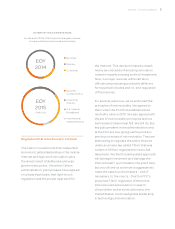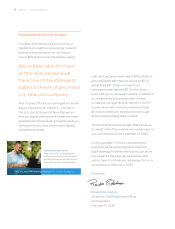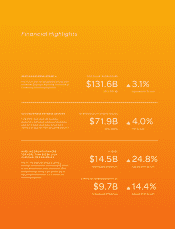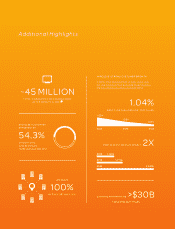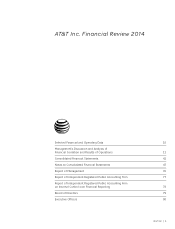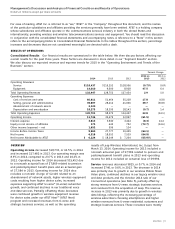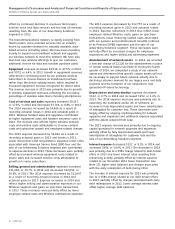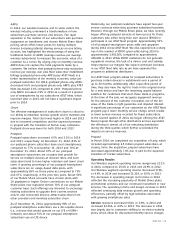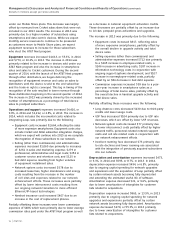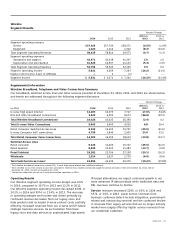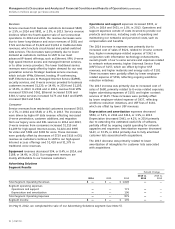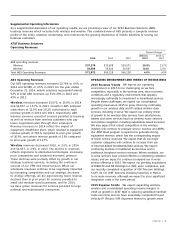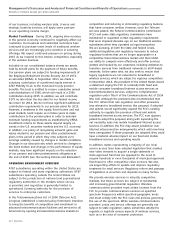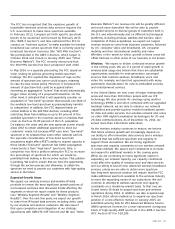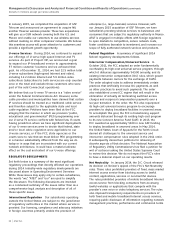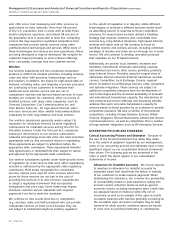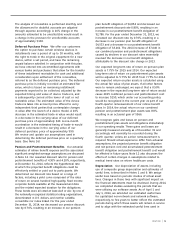AT&T Wireless 2014 Annual Report Download - page 17
Download and view the complete annual report
Please find page 17 of the 2014 AT&T Wireless annual report below. You can navigate through the pages in the report by either clicking on the pages listed below, or by using the keyword search tool below to find specific information within the annual report.
AT&T INC.
|
15
Historically, our postpaid customers have signed two-year
service contracts when they purchase subsidized handsets.
However, through our Mobile Share plans, we have recently
begun offering postpaid services at lower prices for those
customers who either bring their own devices (BYOD) or
participate in our AT&T Next program. Approximately 52%
of all postpaid smartphone gross adds and upgrades
during 2014 chose AT&T Next. We also experienced a sharp
rise in the number of BYOD gross adds during 2014 to
approximately 1,492,000, compared to approximately
400,000 in 2013. While BYOD customers do not generate
equipment revenue, the lack of a device cost and subsidy
helps improve our margins. We expect continued increases
in our AT&T Next take rate as we have expanded the
program to additional distributors.
Our AT&T Next program allows for postpaid subscribers to
purchase certain devices in installments over a period of
up to 30 months. Additionally, after a specified period of
time, they also have the right to trade in the original device
for a new device and have the remaining unpaid balance
satisfied. For customers that elect these trade-in programs,
at the time of the sale, we recognize equipment revenue
for the amount of the customer receivable, net of the fair
value of the trade-in right guarantee and imputed interest.
A significant percentage of our customers on the AT&T Next
program pay a lower monthly service charge, which results
in lower service revenue recorded for these subscribers.
In the second quarter of 2014, we began offering the AT&T
Next program through other distributors and we expanded
the offering to almost all of our remaining distributors
during the third quarter, which further accelerated the
impacts on service revenues.
Prepaid
In March 2014, we completed our acquisition of Leap, which
included approximately 4.5 million prepaid subscribers at
closing. Since the acquisition, prepaid subscribers have
decreased approximately 7.0% due in part to the expected
transition of Cricket subscribers.
Operating Results
Our Wireless segment operating income margin was 23.1%
in 2014, compared to 25.6% in 2013 and 24.9% in 2012.
Our Wireless segment operating income decreased $796,
or 4.4%, in 2014 and increased $1,329, or 8.0%, in 2013.
The decreases in operating margin and income in 2014
reflected the increasing popularity of Mobile Share plans,
promotional activities and our continued investment in new
services. The operating income and margin increase in 2013
reflected continuing data revenue growth and operating
efficiencies, partially offset by high subsidies associated
with growing smartphone sales.
Service revenues decreased $520, or 0.8%, in 2014 and
increased $2,366, or 4.0%, in 2013. The decrease in 2014
was largely due to customers shifting to no-device-subsidy
plans, which allow for discounted monthly service charges
ARPU
In 2014, our wireless business, and to some extent, the
wireless industry, underwent a transformation in how
subscribers purchase services and devices. The rapid
expansion in the number of our subscribers who purchase
equipment on installment and choose Mobile Share Value
pricing, which offers lower prices for having multiple
devices (including tablets) sharing services on one billing
account, has highlighted the shortcomings of using the
traditional metric of ARPU (average revenue per average
wireless subscribers) to measure the economic value of a
customer to a carrier. By relying only on monthly revenue,
ARPU does not capture the total payments made by a
customer. We believe that postpaid phone-only subscriber
revenue per average user plus Next subscriber installment
billings (postpaid phone-only ARPU plus AT&T Next) is a
better representation of the monthly economic value per
postpaid subscriber. For 2014, postpaid phone-only ARPU
decreased 6.6% and postpaid phone-only ARPU plus AT&T
Next decreased 2.6% compared to 2013. Postpaid phone-
only ARPU increased 2.9% in 2013 as a result of a greater
use of smartphones by our subscribers. AT&T Next, which
launched later in 2013, did not have a significant impact
prior to 2014.
Churn
The effective management of subscriber churn is critical to
our ability to maximize revenue growth and to maintain and
improve margins. Total churn was higher in 2014 and 2013
due to increased competition and the expected pressure
in prepaid with the transition of former Leap customers.
Postpaid churn was lower for both 2014 and 2013.
Postpaid
Postpaid subscribers increased 4.5% and 3.0% in 2014
and 2013, respectively. At December 31, 2014, 83% of
our postpaid phone subscriber base used smartphones,
compared to 77% at December 31, 2013 and 70% at
December 31, 2012. About 97% of our postpaid
smartphone subscribers are on plans that provide for
service on multiple devices at reduced rates, and such
subscribers tend to have higher retention and lower churn
rates. A growing percentage of our postpaid smartphone
subscribers are on usage-based data plans, with
approximately 85% on these plans as compared to 75%
and 67%, respectively, in the prior two years. About 50%
of our Mobile Share accounts have chosen plans with
10 gigabytes or higher. Device connections on our Mobile
Share plans now represent almost 70% of our postpaid
customer base. Such offerings are intended to encourage
existing subscribers to upgrade their current services
and/or add connected devices, attract subscribers from
other providers and minimize subscriber churn.
As of December 31, 2014, approximately 90% of our
postpaid smartphone subscribers use a 4G-capable device
(i.e., a device that would operate on our LTE or HSPA+
network), and about 75% of our postpaid smartphone
subscribers use an LTE device.


